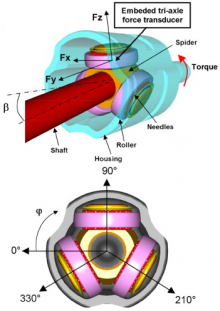If you would like to see more information on this case study, click here!
You can request this case study and a WCDE staff member will get back to you.
 The University of Waterloo Formula Motorsports (UWFM) team consists of over 40 student members. The team builds a small Formula-style racecar as an educational engineering project to obtain practical engineering skills and compete annually in the Formula SAE competition. During the testing process of the 2010 FSAE car, the team had multiple failures with the drivetrain system, particularly with the constant velocity (CV) joints. CV joints used in UW FSAE car are tripode type with rollers on a spider shaft that fit into a tulip housing with cylindrical tracks, and the joints connect the differential to the half shafts as well as connecting the outer ends. CV Joints are designed to transmit torque while accommodating both axial and angular misalignments. In this particular situation, the CV joints would fail after short service duration. After failure, plastic deformation of the tulip housing tracks was observed at the contact interface with the steel rollers.
The University of Waterloo Formula Motorsports (UWFM) team consists of over 40 student members. The team builds a small Formula-style racecar as an educational engineering project to obtain practical engineering skills and compete annually in the Formula SAE competition. During the testing process of the 2010 FSAE car, the team had multiple failures with the drivetrain system, particularly with the constant velocity (CV) joints. CV joints used in UW FSAE car are tripode type with rollers on a spider shaft that fit into a tulip housing with cylindrical tracks, and the joints connect the differential to the half shafts as well as connecting the outer ends. CV Joints are designed to transmit torque while accommodating both axial and angular misalignments. In this particular situation, the CV joints would fail after short service duration. After failure, plastic deformation of the tulip housing tracks was observed at the contact interface with the steel rollers.
Dominic Chomko, a Mechanical Engineering co-op student and a member of the University of Waterloo Formula Motorsports team, set out to redesign a CV joint/hub for the FSAE car which would be both light weight and sufficiently robust.
The teaching objective of this case is to illustrate engineering design process and process design. Therefore, the main expected learning outcome is for students to practice design synthesis along with project management concepts. The case can be used to walk through the engineering design process, and conceptualize adequate solutions based on the design requirements. The case is proposed to be used in Management Engineering Design Project 1(MSCI 401) and Mechanical Design 1 (ME 322) courses
If you would like to see more information on this case study, click here!
You can request this case study and a WCDE staff member will get back to you.
Contact Waterloo Cases in Design Engineering
Steve Lambert
Tel: (519) 888-4728
Email: steve@uwaterloo.ca
The University of Waterloo acknowledges that much of our work takes place on the traditional territory of the Neutral, Anishinaabeg and Haudenosaunee peoples. Our main campus is situated on the Haldimand Tract, the land granted to the Six Nations that includes six miles on each side of the Grand River. Our active work toward reconciliation takes place across our campuses through research, learning, teaching, and community building, and is co-ordinated within the Office of Indigenous Relations.